11.1 Naming Carboxylic Acids, Nitriles and Carboxylic Acid Derivatives
Carboxylic Acids, RCO2H
Simple carboxylic acids derived from open-chain alkanes are systematically named by replacing the terminal –e of the corresponding alkane name with –oic acid. The –CO2H carbon atom is numbered C1.
 Compounds that have a –CO2H group bonded to a ring are named using the suffix –carboxylic acid. The CO2H carbon is attached to C1 in this system and is not itself numbered. As a substituent, the CO2H group is called a carboxyl group.
Compounds that have a –CO2H group bonded to a ring are named using the suffix –carboxylic acid. The CO2H carbon is attached to C1 in this system and is not itself numbered. As a substituent, the CO2H group is called a carboxyl group.
 Because many carboxylic acids were among the first organic compounds to be isolated and purified, quite a few common names exist (Table 11.1). Biological chemists, in particular, make frequent use of these names, so you may find yourself referring back to this list on occasion. We’ll use systematic names in this book, with a few exceptions such as formic (methanoic) acid and acetic (ethanoic) acid, whose names are accepted by IUPAC and are so well known that it makes little sense to refer to them any other way.
Because many carboxylic acids were among the first organic compounds to be isolated and purified, quite a few common names exist (Table 11.1). Biological chemists, in particular, make frequent use of these names, so you may find yourself referring back to this list on occasion. We’ll use systematic names in this book, with a few exceptions such as formic (methanoic) acid and acetic (ethanoic) acid, whose names are accepted by IUPAC and are so well known that it makes little sense to refer to them any other way.
Also listed in Table 11.1 are the names of acyl groups  derived from the parent acids. Except for the eight entries at the top of Table 11.1, whose names have a –yl ending, all other acyl groups are named using an –oyl ending.
derived from the parent acids. Except for the eight entries at the top of Table 11.1, whose names have a –yl ending, all other acyl groups are named using an –oyl ending.
Table 11.1 Common Names of Some Carboxylic Acids and Acyl Groups
|
Structure |
Name |
Acyl group |
|
HCO2H |
Formic |
Formyl |
|
CH3CO2H |
Acetic |
Acetyl |
|
CH3CH2CO2H |
Propionic |
Propionyl |
|
CH3CH2CH2CO2H |
Butyric |
Butyryl |
|
HO2CCO2H |
Oxalic |
Oxalyl |
|
HO2CCH2CO2H |
Malonic |
Malonyl |
|
HO2CCH2CH2CO2H |
Succinic |
Succinyl |
|
HO2CCH2CH2CH2CO2H |
Glutaric |
Glutaryl |
|
HO2CCH2CH2CH2CH2CO2H |
Adipic |
Adipoyl |
|
H2C═CHCO2H |
Acrylic |
Acryloyl |
|
HO2CCH═CHCO2H |
Maleic (cis) Fumaric (trans) |
Maleoyl Fumaroyl |
|
HOCH2CO2H |
Glycolic |
Glycoloyl |
|
Lactic |
Lactoyl |
|
|
|
Pyruvic |
Pyruvoyl |
|
|
Glyceric |
Glyceroyl |
|
|
Malic |
Maloyl |
|
|
Oxaloacetic |
Oxaloacetyl |
|
|
Benzoic |
Benzoyl |
|
|
Phthalic |
Phthaloyl |
Nitriles, RC≡N
Compounds containing the –C≡N functional group are called nitriles and can undergo some chemistry similar to that of carboxylic acids. Simple open-chain nitriles are named by adding –nitrile as a suffix to the alkane name, with the nitrile carbon numbered C1.
 Nitriles can also be named as derivatives of carboxylic acids by replacing the –ic acid or –oic acid ending with –onitrile, or by replacing the –carboxylic acid ending with –carbonitrile. The nitrile carbon atom is attached to C1 but is not itself numbered.
Nitriles can also be named as derivatives of carboxylic acids by replacing the –ic acid or –oic acid ending with –onitrile, or by replacing the –carboxylic acid ending with –carbonitrile. The nitrile carbon atom is attached to C1 but is not itself numbered.
 If another carboxylic acid derivative is present in the same molecule, the prefix cyano– is used for the C≡N group.
If another carboxylic acid derivative is present in the same molecule, the prefix cyano– is used for the C≡N group.
 Problem 11.1
Problem 11.1
Give IUPAC names for the following compounds:
(a)

(b)

(c)

(d)
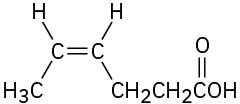
(e)

(f)

Problem 11.2
Draw structures corresponding to the following IUPAC names:
(a) 2,3-Dimethylhexanoic acid
(b) 4-Methylpentanoic acid
(c) trans-1,2-Cyclobutanedicarboxylic acid
(d) o-Hydroxybenzoic acid
(e) (9Z,12Z)-9,12-Octadecadienoic acid
(f) 2-Pentenenitrile
Acid Halides, RCOX
Acid halides are named by identifying first the acyl group and then the halide. The acyl group name is derived from the carboxylic acid name by replacing the –ic acid or –oic acid ending with –oyl, or the –carboxylic acid ending with –carbonyl. To keep things interesting, however, IUPAC recognizes eight exceptions for which a –yl rather than an –oyl ending is used: formic (formyl), acetic (acetyl), propionic (propionyl), butyric (butyryl), oxalic (oxalyl), malonic (malonyl), succinic (succinyl), and glutaric (glutaryl).
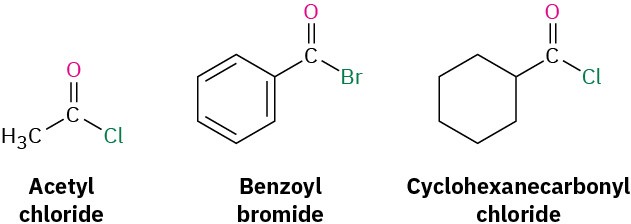
Acid Anhydrides, RCO2CORʹ
Symmetrical anhydrides of unsubstituted monocarboxylic acids and cyclic anhydrides of dicarboxylic acids are named by replacing the word acid with anhydride.
 Unsymmetrical anhydrides—those prepared from two different carboxylic acids—are named by listing the two acids alphabetically and then adding anhydride.
Unsymmetrical anhydrides—those prepared from two different carboxylic acids—are named by listing the two acids alphabetically and then adding anhydride.

Esters, RCO2Rʹ
Esters are named by first identifying the alkyl group attached to oxygen and then the carboxylic acid, with the –ic acid ending replaced by –ate.
Amides, RCONH2
Amides with an unsubstituted –NH2 group are named by replacing the –oic acid or –ic acid ending with –amide, or by replacing the –carboxylic acid ending with –carboxamide.
 If the nitrogen atom is further substituted, the compound is named by first identifying the substituent groups and then the parent amide. The substituents are preceded by the letter N to identify them as being directly attached to nitrogen.
If the nitrogen atom is further substituted, the compound is named by first identifying the substituent groups and then the parent amide. The substituents are preceded by the letter N to identify them as being directly attached to nitrogen.

Thioesters, RCOSRʹ
Thioesters are named like the corresponding esters. If the related ester has a common name, the prefix thio– is added to the name of the carboxylate: acetate becomes thioacetate, for instance. If the related ester has a systematic name, the –oate or –carboxylate ending is replaced by –thioate or –carbothioate: butanoate becomes butanethioate and cyclohexanecarboxylate becomes cyclohexanecarbothioate, for instance.

Acyl Phosphates, RCO2PO32– and RCO2PO3Rʹ–
Acyl phosphates are named by citing the acyl group and adding the word phosphate. If an alkyl group is attached to one of the phosphate oxygens, it is identified after the name of the acyl group. In biological chemistry, acyl adenosyl phosphates are particularly common.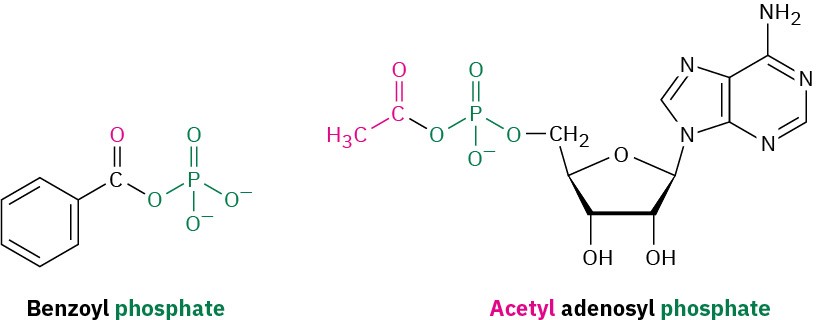 A summary of nomenclature rules for carboxylic acid derivatives is given in Table 11.2.
A summary of nomenclature rules for carboxylic acid derivatives is given in Table 11.2.
Table 11.2 Nomenclature of Carboxylic Acid Derivatives
|
Structure |
Name ending |
|
|
Carboxylic acid |
|
-ic acid (-carboxylic acid) |
|
Acid halide |
|
-oyl halide (-carbonyl halide) |
|
Acid anhydride |
|
anhydride |
|
Amide |
 |
-amide (-carboxamide) |
|
Ester |
|
-oate (-carboxylate) |
|
Thioester |
|
-thioate (-carbothioate) |
|
Acyl phosphate |
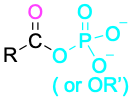 |
-oyl phosphate |
Problem 11.3
Give IUPAC names for the following substances:
(a)

(b)
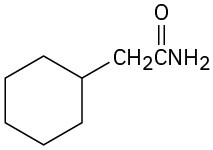
(c)
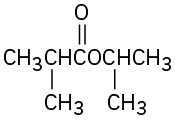
(d)
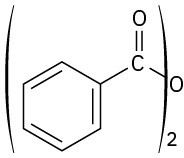
(e)

(f)
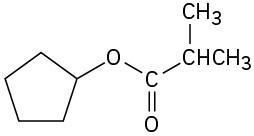
(g)

(h)
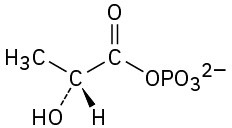
(i)
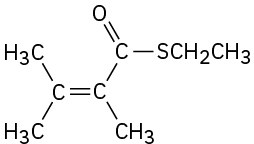
Problem 11.4
Draw structures corresponding to the following names:
(a) Phenyl benzoate
(b) N-Ethyl-N-methylbutanamide
(c) 2,4-Dimethylpentanoyl chloride
(d)Methyl 1-methylcyclohexanecarboxylate
(e) Ethyl 3-oxopentanoate
(f) Methyl p-bromobenzenethioate
(g) Formic propanoic anhydride
(h) cis-2-Methylcyclopentanecarbonyl bromide








